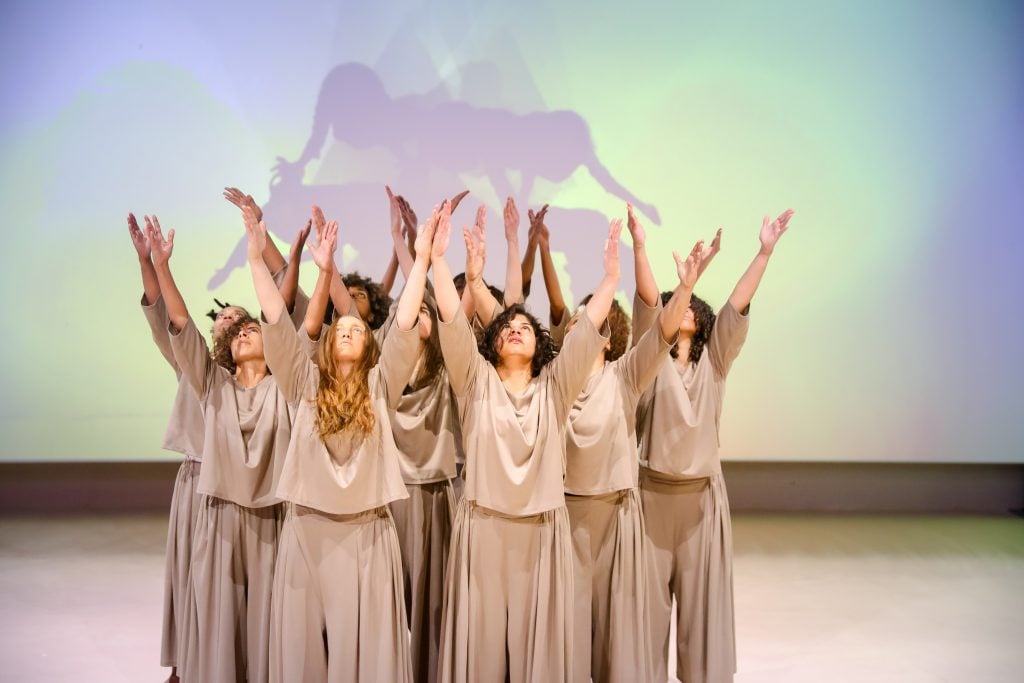A dozen Riyadh-based dancers in cream-colored clothes moved to the blended guttural sounds of a South African Xhosa song, a Sufi chant, and a Fijiri folk song from the Arabian Gulf. Their asynchronous movements carried the explosive intensity of a simmering pot. Behind them stood a video installation of their bodies in aerial view. Marwah AlMugait, the artist who made this piece, called This Sea is Mine, looked around intrepidly at the hundreds gathered for Saudi Arabia’s inaugural Diriyah Contemporary Art Biennale. People seemed compelled not just by the visceral choreography of women performing live, but by the act of witnessing this historic moment in the artistic life of a country.
Attention to the plight of women was also a strong theme at the adjacent Tuwaiq International Sculpture Symposium, one of the government-backed programs of Riyadh Art. New Zealand artist Anna Korver’s abstract sculpture evoking draped female figures won an award on December 10 and her work is a part of the city’s first public initiative to build 1,000 permanent urban sculptures.
These were paradigm-shifting moments as the art world congregated in Saudi Arabia for the inaugural biennial, called “Feeling the Stones” and the adjacent symposium in Riyadh, as well as Misk Art Week. Meanwhile, in Jeddah, a new art space Hayy Jameel has opened.
A sense of urgent transformation can be felt in the Middle Eastern nation, which was culturally insulated from the world until Prince Mohammed Bin Salman laid out Vision 2030’s social and economic reforms five years ago. Through its cultural endeavors, the newly formed ministry of culture has been articulating a position focused on enriching local cultural contexts while participating in the global art discourse.
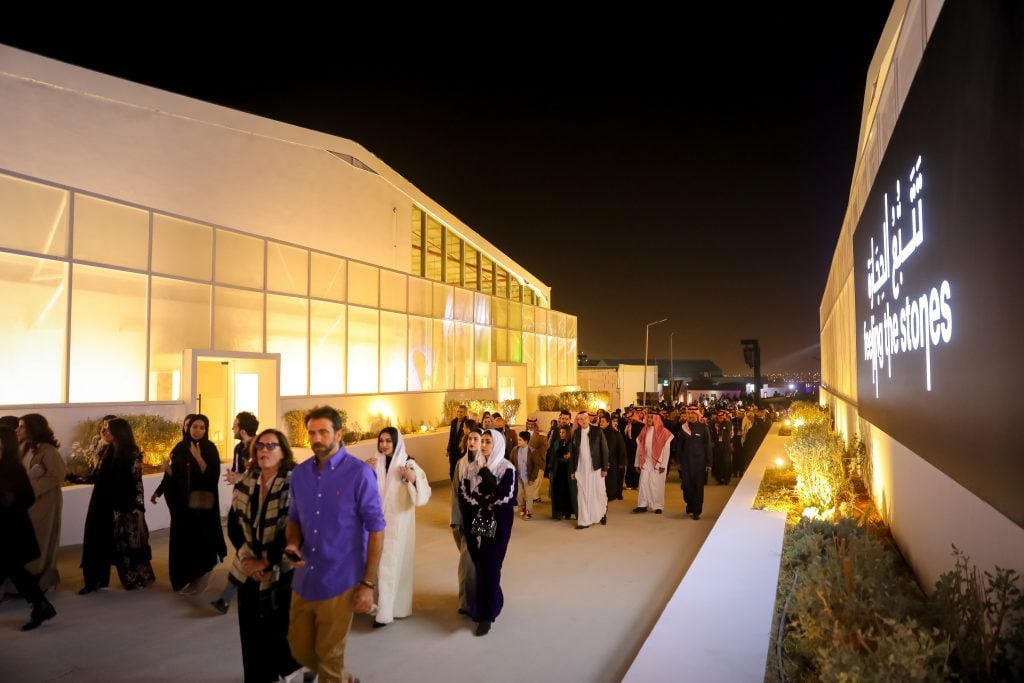
Diriyah Contemporary Art Biennale launch event. Courtesy Canvas and Diriyah Biennal Foundation
A New Center for Art
The biennial, which is on view until March 11, 2022, spans six warehouses in the JAX district in the industrial part of Diriyah on the northwest fringes of Riyadh, an area that will be refurbished into an arts hub in the coming years.
The show title—“Feeling the Stones”—comes from a saying about crossing a river that Chinese revolutionary leader Deng Xiaoping used frequently during the 1980s. “He used it as a way of talking about economic and cultural reform, the platforms of his decade and a half in power,” said Philip Tinari, head of the UCCA Center for Contemporary Art in Beijing and curator of the Diriyah Biennale alongside Wejdan Reda, Shixuan Luan, and Neil Zhang. “It was a time when China was reassessing its system and opening up to the world.”
The saying was actually first coined in 1980 by Chen Yun, a leader of the Chinese Communist Party, in relation to garnering economic stability (it later became associated with Deng as he helped China become an economic powerhouse). “I felt like [the expression] has resonances with where things are in Saudi today in the aftermath of massive changes and big dreams on the horizon,” said Tinari. “It’s an abstract way of thinking about artistic experimentation and practice.”
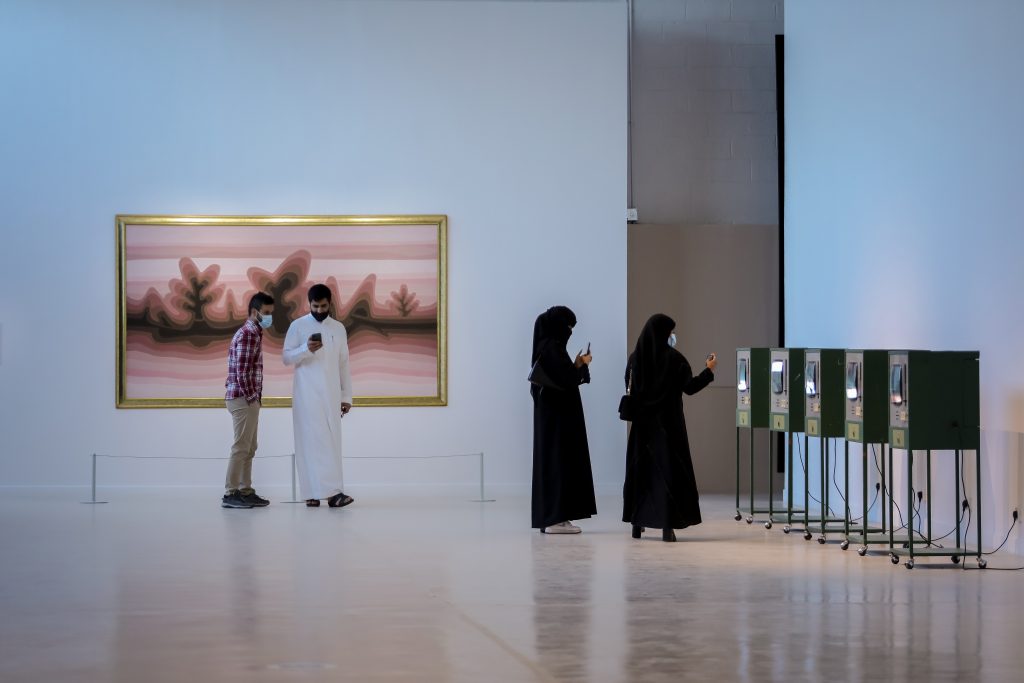
Installation view, Diriyah Contemporary Art Biennale 2021. Courtesy Canvas and Diriyah Biennale Foundation
He added that many artists included in the exhibition work with a method “that’s iterative yet experimental, tentative yet directed, going from one side to the other by charting the course as it is traveled.” He noted that the biennial came together in a similar way, by putting in place “structures and processes at the same time as doing them.”
This approach has allowed for magical encounters within the show itself such as Zahra Al Ghamdi’s sculpture Birth of a Place (2021), which was inspired by the ruins of mud-houses in Diriyah and which appears as a clever 3D extension of Xu Bing’s lightbox Background Story: Streams and Mountains Without End (2014), which itself mimics a traditional landscape painting though it is actually sculpted from newspaper and plant detritus.
The rules of engagement for the cultural scene in what is an extremely conservative nation are still unclear. Tinari was likely tapped for his experience in running a museum in China, which requires the fine art of dealing with the People’s Republic and censorship.
“What’s become clear to me is that any context has things that can and can’t be said,” said Tinari. “I always look back to working on ‘Art and China after 1989: Theater of the World’ at the Guggenheim [in 2017] and finding ourselves on the wrong side of animal rights, having to deactivate the presentations of three artists in New York City…The question is less what is censorship and more what is respect for cultural mores in a context that’s not your own?”
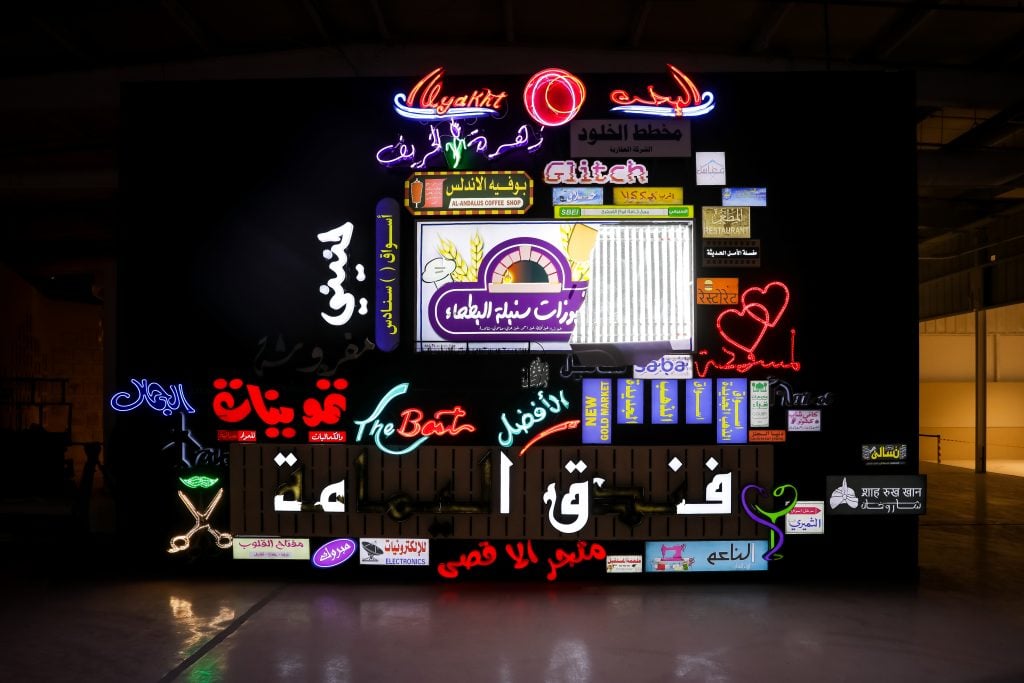
Abdullah Al Othman, Manifesto, The Language & City (2021). Image courtesy Diriyah Biennale Foundation and the artist.
A Bridge to the West and East
More than half of the 64 artworks are by Saudi or Chinese artists—and nearly half the works are newly commissioned. The works are divided into six “chapters” that flow via pathways and ramps that link each of the thematic sections of a warehouse (designed by Saudi architecture studio Bricklab). The color of the rooms reflects the natural landscape beyond the show, and walls are punctured, letting in natural light and views of Wadi Hanifah. It is a thoughtful and considered showcase that does not sensationalize the seismic shift Saudi Arabia is experiencing but instead pushes on boundaries without breaking them.
South African artist William Kentridge’s More Sweetly Play the Dance (2015), in which celebratory music is played by shadow projections, heralds the first chapter, “Crossing the River.” Here, one will also find Maha Malluh’s wall-sized World Map (2021) of 3,840 cassette tapes bearing religious sermons remain, silent relics of an analog world of conservative Islam. It lies adjacent to Richard Long’s Red Earth Circle (1989/2021) made from red clay from Saudi Arabia that was first created in 1989 for Centre Pompidou’s groundbreaking “Magicians de Terre,” considered the first exhibition of global contemporary art.
The biennial often juxtaposes the 1980s Chinese avant-garde with the historical emergence of art in Saudi Arabia in the 1990s. Yet Tinari emphasizes that there are important differences between these moments in the two nations. “A lot of artistic production in Saudi isn’t actually just about the question of nationhood or national identity, in a way that I think burdened the artistic production in China for a long time,” he said. He added that Saudi Arabia was more connected to the global scene than China during its transformation, “for better or worse.”

Sarah Abu Abdallah and Ghada Al Hassan, ‘Horizontal Dimensions’, 2021, courtesy Canvas and Diriyah Biennale Foundation
Elsewhere, unexpected threads unfold: prominent Chinese artist Wang Luyan’s miniature humanoid sculptures converse with Ayman Yossri Daydban’s paintings of alienated figures from the 1990s. There are conversations between Saudi artists as well—Ahmed Mater’s video installation of life before and after the oil boom in Desert Meeting (2021) is installed nearby Mohammed Al Saleem’s modernist ode to arid topography, Desert Spring (1987).
Comments on the family unit, which in Saudi Arabia extends to the larger tribe and is traced through patrilineality, manifest in Daniah Al Saleh’s That Which Remains (2021), which blurs computer-generated archival portraits with personal footage mixing official and personal narratives. It is set against Japan’s Koki Tanaka’s provocative Abstracted/Family (2020), which stages a mock nuclear family and comments on estrangement and minority politics. Manal Al Dowayan’s brass leaf installation of matrilineal lines, on the other hand, through the drawings and recordings of 300 women from Dammam, Riyadh, and Jeddah in Tree of Guardians (2014), brings invisible histories to light.
But one of the most riveting sections was “Brave New Worlds,” which focused on our planet’s apocalyptic present of nearly extinct species, uprooted plant life and solitary automatons. A film by Ando Wekua focuses on a burning palm tree overlaid with screeching sounds and Ayman Zedani’s recorded intonations of the endangered Arabian Sea humpback whales laments a collective environmental demise. Muhannad Shono’s tired mark-making robotic sculpture and Lawrence Lek’s envisioning of an automated hotel depict a world without humans. Also on view was Sarah Brahim’s video performance Soft Machines/Far Away Engines (2021) which traces dancers who multiply, heave, and touch, providing a bit of solace in this grim setting.
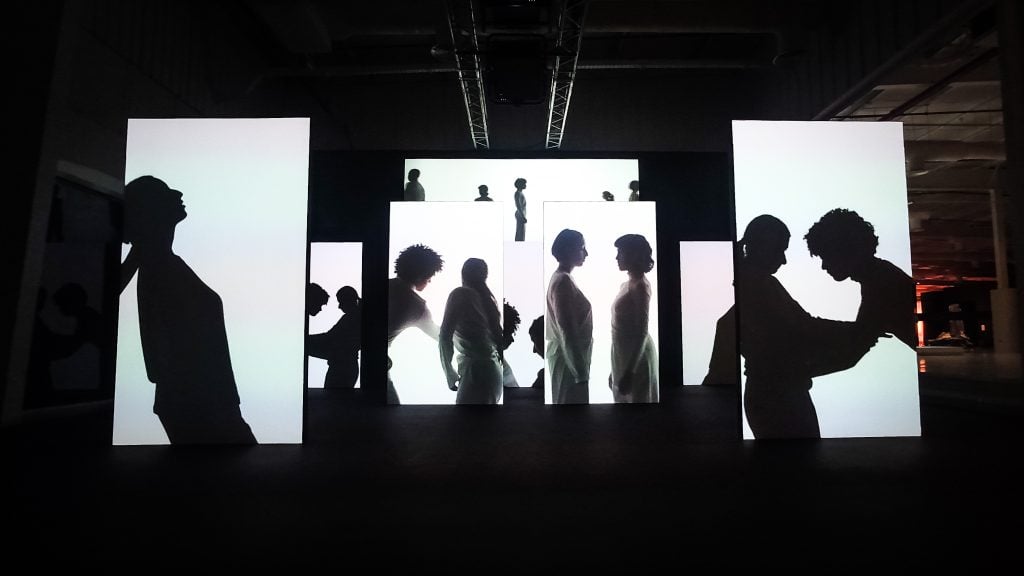
Sarah Brahim Soft Machines/Far Away Engines. Image courtesy Diriyah Biennale Foundation and the artist.
A Dizzying Transformation
Despite the curatorial prowess of the show, it would be a mistake to consider this biennial as completely unprecedented. Although there is now a shining focus on the capital Riyadh, Jeddah has enjoyed a thriving art scene for decades, which began underground with the independent collective Edge of Arabia in 2003 and continued with the private philanthropy of the Saudi Art Council in 2014. What is new, however, is the openness to developing deeply collaborative curatorial models at an international level. In addition to the biennial, which brought on Beijing-based Tinari and other UCCA curators from China, Hayy Jameel co-curated an exhibition on food futures called “Staple: What’s on your plate” together with the U.K.-based Delfina Foundation.
That show was bustling like the biennial, with 1,650 visitors attending its opening on December 6. “Jeddah is a cosmopolitan city, a gateway for pilgrims,” said Antonia Carver, director of Art Jameel. She added that the exhibition, which includes artists from South Asia, Barbados, Bangladesh, and the Congo is “less about a nation-to-nation” discourse and more about “the city’s connections to elsewhere.” The history of Jeddah, she said, is “intertwined with other places, defying the stereotype as a place that’s closed off.”
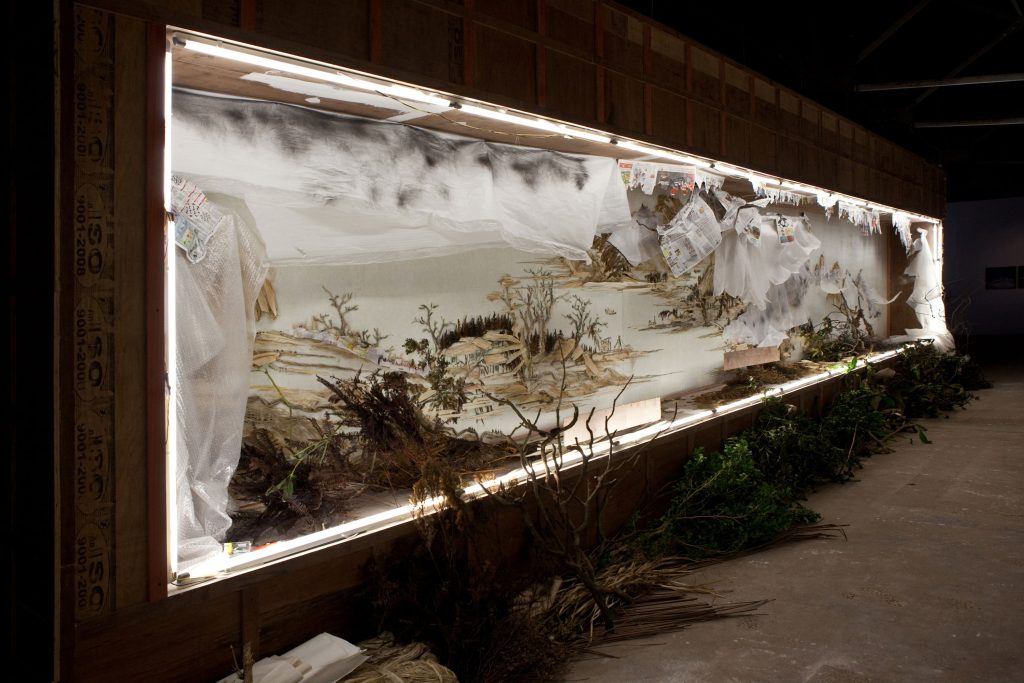
Xu Bing, Background Story Streams and Mountains Without End (2013). Image courtesy Diriyah Biennale Foundation and the artist.
These dramatic moves in bringing both Riyadh and Jeddah onto the world stage are somewhat dizzying. While the biennial has most certainly become a catalyst for the Kingdom’s role in the region’s artistic landscape, a major question looms about the extent to which cultural production will be grounded by local government bodies and infrastructures of power as this art scene attempts to situate itself within the globalized art world.
Rashed Al Shashai’s contribution to the biennial, Cultural Wall (2021), a spiraling sculpture of wicker and steel, alludes to the structural problems implicated in such moments of progress. Even as a local, he says the future shape of Saudi Arabia’s culture scene is anything but clear: “It’s like trying to make sense of hazy shapes out from a fast-moving car.” What is sure, in any case, is that this indeterminate present is a new starting point for Saudi Arabia, one that will usher in an artistic era that is not seen as a counterpart to the Global North but which is very much coming into its own.
The Diriyah Contemporary Art Biennale is on view in Riyadh until March 11, 2022.
